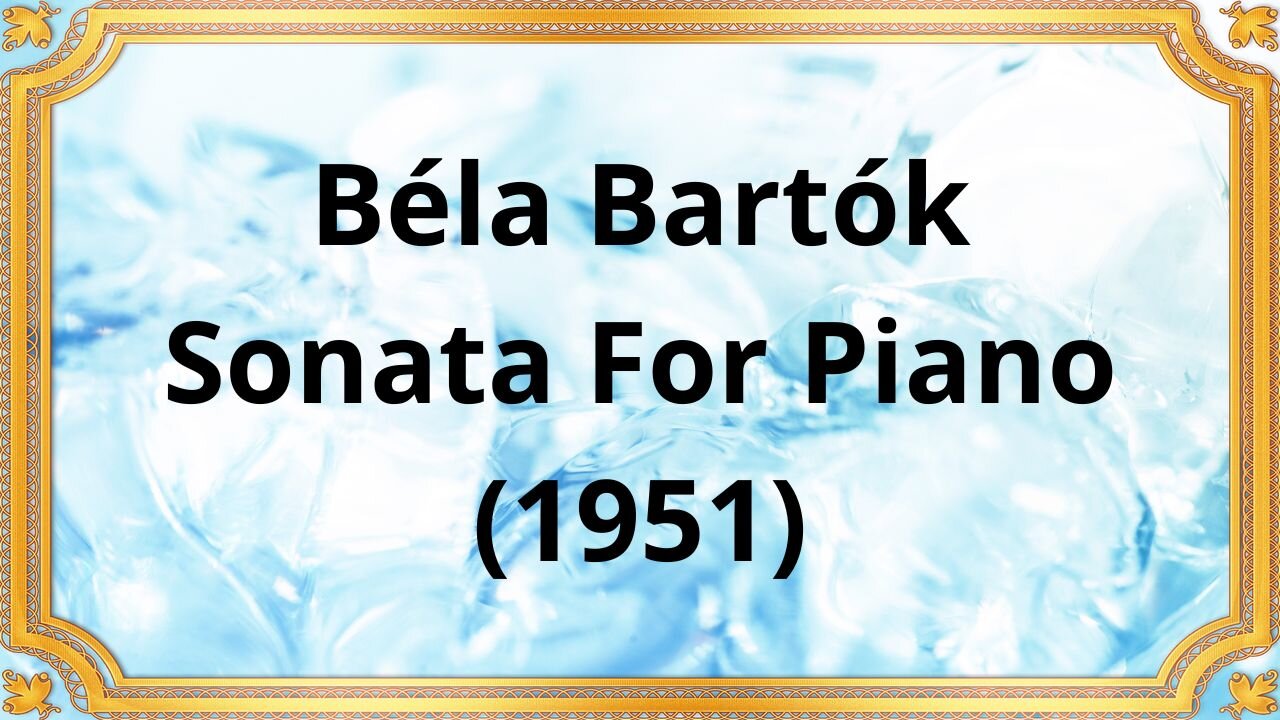Premium Only Content

Béla Bartók Sonata For Piano (1951)
#ClassicalMusic #BélaBartók #SonataForPiano #HungarianComposer #20thCenturyMusic #FolkInfluences #MusicalStructure #RhythmicComplexity #ExpressiveDynamics #ModernistComposition
Publication date 1951
ZADEL SKOLOVSKY PIANO
Béla Bartók's Sonata for Piano is a captivating composition that exemplifies the unique musical language and innovative spirit of the renowned Hungarian composer. Written in the early 20th century, this sonata showcases Bartók's exceptional ability to blend folk influences with modernist techniques, resulting in a work that captivates listeners with its rhythmic complexity, expressive dynamics, and rich musical structure.
Composed between 1926 and 1927, Bartók's Sonata for Piano emerged during a time of great artistic transformation. Bartók, along with his contemporary Zoltán Kodály, embarked on extensive field research to collect and preserve the folk music of Central and Eastern Europe. This exploration of folk traditions greatly influenced Bartók's compositional style, leading him to incorporate folk elements into his works, including the Sonata for Piano.
Bartók's Sonata for Piano is a testament to his unique musical language and innovative approach to composition. The sonata is characterized by its rhythmic complexity, featuring intricate and syncopated rhythms that create a vibrant and energetic atmosphere. Bartók's use of folk influences can be heard through the incorporation of modal and pentatonic scales, as well as the utilization of folk-like melodies and dance rhythms. These elements infuse the sonata with a sense of cultural identity and evoke a connection to Bartók's Hungarian roots.
One of the most remarkable aspects of Bartók's Sonata for Piano is its expressive dynamics. The composition encompasses a wide range of emotions, from moments of fiery passion to introspective contemplation. Bartók's skillful use of contrasting themes, textures, and harmonic language allows the music to unfold in a way that captivates and engages the listener.
The sonata follows a traditional three-movement structure. The first movement, marked "Allegro moderato," introduces the main themes and establishes a sense of urgency and momentum. The second movement, "Sostenuto e pesante," provides a contrasting atmosphere with its brooding and introspective character. The sonata concludes with a lively and energetic third movement, "Allegro molto," filled with intricate rhythms and virtuosic passages.
Bartók's Sonata for Piano remains a significant work in the realm of classical music. Its fusion of folk influences and modernist techniques has had a lasting impact on subsequent generations of composers. The sonata's rhythmic complexity, expressive dynamics, and rich musical structure continue to inspire performers and intrigue audiences, showcasing Bartók's innovative spirit and his ability to push the boundaries of musical expression.
Béla Bartók's Sonata for Piano is a captivating composition that embodies the composer's unique musical language and innovative approach. Its incorporation of folk influences, rhythmic complexity, and expressive dynamics create a vibrant listening experience that resonates with audiences. The sonata stands as a testament to Bartók's legacy as a leading figure in 20th-century music and continues to captivate and inspire musicians and listeners alike. Bartók's Sonata for Piano remains an enduring masterpiece that invites us to explore the rich and vibrant world of his musical imagination.
You have the opportunity to support the channel:
https://destream.net/live/RadSiarAl/donate
https://www.buymeacoffee.com/6355radsiaral
-
 2:08:01
2:08:01
The Quartering
6 hours agoElon Musk Has A MELTDOWN & Leaks DM's, Matt Walsh Vs OF Girls, & the WORST Video We've Ever Seen!
112K47 -
 44:54
44:54
Steve-O's Wild Ride! Podcast
6 hours ago $2.94 earnedMark Wahlberg Threatened To Beat Up Jackass Cast Member - Wild Ride #251
34.4K8 -
 LIVE
LIVE
tacetmort3m
7 hours ago🔴 LIVE - PUNISHING THEM ALL TO RANK UP - MARVEL RIVALS RANKED
98 watching -
 36:14
36:14
Capitol Spotlight
3 hours ago $0.65 earnedWho is Rep. Jim Jordan outside of Congress?
12.2K1 -
 3:34:16
3:34:16
SIEFE
5 hours agoRED DEAD REDEMPTION 2 LIVE!
49.8K5 -
 1:16:43
1:16:43
Russell Brand
6 hours agoHollywood Hypocrisy and Fighting Corruption: Rob Schneider Speaks Out! – SF521
111K102 -
 7:17
7:17
Rethinking the Dollar
6 hours agoTrump's Crypto Reserve Plan Shocks Everyone
25K3 -
 11:20
11:20
China Uncensored
7 hours agoRedNote: Americans Flock to Chinese App Ahead of TikTok Ban
27.7K13 -
 1:58:03
1:58:03
The Charlie Kirk Show
6 hours agoConfirmation Marathon: Day 3 | Sen. Scott, Plume | 1.16.2025
146K40 -
 2:54:51
2:54:51
The Dana Show with Dana Loesch
6 hours agoWORST FAREWELL SPEECH IN HISTORY | The Dana Show LIVE On Rumble!
41.3K4